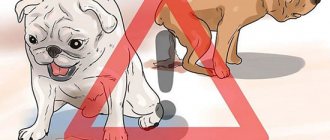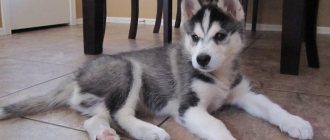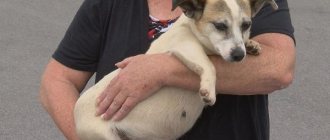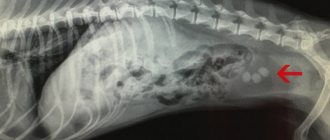You can only observe green stool in your dog for the first time after switching to food, because the dog’s body needs some time to adapt to the new composition. But the greenish stool should disappear after a few days.
There are other causes that have nothing to do with food that can cause green stool. Green stool is a sign that food has passed through the intestines faster than usual, that is, before it changes color from green to brown. The most common causes of this are: salmonella, lamblia and intestinal disorders.
Causes of green stool
Speaking about the prerequisites for the appearance of this type of bowel movement, it is difficult to single out one dominant reason that can lead to the appearance of a characteristic shade. This unusual color of a dog’s stool may be associated with both serious gastrointestinal pathologies and the absorption of poisons that must be removed from the animal’s body as quickly as possible. Green stool appears due to the asymptomatic development of a number of diseases
Diseases
Among the pathological reasons why a dog exhibits green feces, the most common are the following:
- inflammatory processes in the gastrointestinal tract;
- fungal and parasitic diseases that depress the animal’s body as a whole, negatively affecting all organ systems;
- penetration of pathogenic bacteria into the dog’s body;
- spread of intestinal infection resulting from the activation of putrefactive microflora;
- impaired intestinal motility (increased peristalsis is often assumed);
- liver dysfunction;
- cholelithiasis and other pathologies affecting the bile ducts. It is this group of diseases that leads to excessive secretion of bile, which turns the pet’s stool an unnatural green color.
Errors in care
In addition to the reasons associated with global disturbances in the functioning of certain organs, there are other reasons rooted in improper conditions for keeping the pet. Seemingly harmless, with constant practice they can lead to serious consequences.
Among these errors are:
- the use of low-quality dry food (as a rule, this refers to representatives of the economy class, sold in every supermarket);
- the dog eating spoiled meat or other expired products, leading to food poisoning;
- a sharp transition to a new type of nutrition. When deciding to switch a pet from dry food to natural food, the owner often rushes things, or even does it in one go. Such speed cannot but lead to digestive problems in the animal. You can read about how to switch a dog to another food in a separate article on our portal;
- changing the feeding schedule. For dogs (as well as for other animals), maintaining a feeding schedule is very important. Every veterinarian advises the owner to accustom his pet to a fixed meal time from childhood. Otherwise, the stomach simply does not have time to produce enough gastric juice to adequately digest food;
- poisoning. Unfortunately, this phenomenon also occurs, since during a walk the dog may eat something not intended for ingestion. In addition, some “activists” deliberately scatter poison in dog walking areas in order to reduce the number of stray dogs.
Other reasons
There are also reasons that cannot be confidently classified into one of the categories discussed above.
Such reasons are difficult to foresee and influence:
- allergic reaction. The concept of “allergy” includes a very wide range of symptoms, one of which may be a change in the color of stool. However, when it comes to allergies, the coloring of stool in a greenish tint is usually accompanied by other changes in the functioning of the body;
- consequences of taking antibiotics. Each animal perceives antibacterial drugs differently. One way or another, antibiotics negatively affect the intestinal microflora, especially if, after treatment, the pet does not take a course of probiotics, which will restore the functioning of the small intestine;
- consequences of routine vaccination. This reason applies mostly to puppies whose immune systems are still weak and difficult to cope with the first vaccinations. Often, after vaccination, puppies' stools become loose and take on an unhealthy green tint. At this moment, the pet’s body is most susceptible to various infections;
- change of milk teeth.
puppy has mucus and blood in stool
Diarrhea in dogs: causes, symptoms, treatment methods
Dog owners are often concerned about issues related to the health of their pets. An unpleasant and alarming symptom is diarrhea in a dog - what to do in such a situation? Some owners don't pay attention to their dog's stomach upset. This behavior can end in big problems.
Diarrhea can be a manifestation of a serious illness or dangerous poisoning. To make the right decision, it is necessary to determine exactly what caused the diarrhea.
Intestinal dysfunction in a dog can sometimes be the result of dysbiosis, lack of vitamins, allergic reactions, gastric arrest, or foreign bodies entering the animal’s gastrointestinal tract.
To establish the cause, you will need to call a veterinarian at home. This is especially true if the animal is exhausted and its condition does not improve. In each individual case, it is necessary to correctly determine the reason why diarrhea appeared. Before drawing conclusions about the need for treatment, you should carefully study the symptoms of the disorder.
Pet owners should be aware of the specific symptoms of stomach upset in pets. These signs include:
Dogs begin to behave restlessly, whine, refuse to eat, and lose weight . They often start vomiting. The animal ceases to control the process of defecation.
Stool with mucus and other stool abnormalities. Causes. Treatment
To determine whether your stool is normal, it is important to know its color. If it is brown in various shades or closer to black, then the stool is normal. Otherwise, you will immediately see unusual changes that may be a reason for examination. If there is mucus in the stool, you should consult a doctor to determine the cause of the mucus.
Source
What does green dog stool mean?
When problems begin with your pet’s health, it doesn’t take long to panic. However, at such moments it is very important to pull yourself together, analyze the situation and not delay a visit to the veterinarian. Especially if the pet’s symptom raises serious concerns.
We recommend reading: How are Cat Mites Transmitted?
Ideally, a healthy pet's stool has a rich brown color, which is due to the color of secretions and enzymes that process the stool while it is still in the gastrointestinal tract. The liver neutralizes substances harmful to the body and produces bile acids necessary for the breakdown of fat. At the same time, a large amount of unprocessed fat often causes diarrhea.
The feces of a healthy dog are well-formed, have no visible inclusions, do not stain the animal’s fur, are smooth and have a moist sheen, are of small volume and have a moderate odor. Defecation occurs approximately 1-3 times a day.
A liquid, greenish-brown or brown puddle of feces in combination with vomiting is observed at the very beginning of deadly viral diseases of the gastrointestinal tract.
Dry food (if it is premium and super premium food), which does not seem appetizing to humans, is a guarantee that the dog’s health will not be at risk. After all, in high-quality food everything is balanced, which is an excellent alternative when the owner feeds the dog unbalanced natural food.
Green stool in a dog usually comes from bile, so problems are possible in the bile ducts and the gallbladder itself. Some foods can also provide “greens”. Many people go to veterinary clinics with just such a problem. It is clear that low-quality food with a lot of dye will not make anyone healthy.
When a dog has green stool, a blood test is done to make a diagnosis, as well as an ultrasound (to know for sure that everything is in order with the internal organs, it is better to be on the safe side).
Source
Clinical picture
Green stool is rarely an “isolated” symptom; in most cases it is accompanied by other painful manifestations, allowing the veterinarian to make a more accurate diagnosis.
You can tell if your pet needs veterinary help immediately by the following symptoms:
- increase or decrease in body temperature;
- general depressed state, lack of need for physical activity;
- unjustified weight loss;
- frequent bouts of vomiting (may remain ineffective);
- lack of interest in food, combined with constant thirst;
- frequent urination;
- blanching or yellowing of the mucous membranes.
The conditions listed above, as a rule, indicate the occurrence of an inflammatory process in one of the pet’s organs. Only a veterinarian can more accurately determine the affected organ and prescribe adequate treatment.
Symptoms can develop either very gradually or abruptly if we are talking about poisoning with poisons. Unfortunately, with this type of intoxication, the owners sometimes do not have time to run to the doctor before the dog dies. If there are errors in diet planning, green stools are not accompanied by other painful manifestations
In case of allergies, dysbacteriosis resulting from long-term treatment with antibiotics and the selection of the wrong food, green stool can act as a single symptom, without causing any particular concern in the dog owner (as well as in the dog itself). However, it is important to understand that a change in the shade of bowel movements indicates malfunctions in the body, which sooner or later will lead to more significant deterioration that can no longer be ignored.
White feces - a consequence of the disease
The formation of white feces in a dog occurs due to a disruption in the flow of bile into the intestines from the liver. Its outflow, in turn, can be a consequence of diseases, among which the most common are:
- Liver cyst.
- Tumors.
- Cholelithiasis.
- Inflammatory disease of the liver and bile ducts (cholangitis, hepatitis, cholangiohepatitis).
- Cirrhosis or fibrosis of the liver and so on.
Separately, veterinarians highlight compression of the bile ducts and liver, associated with animal injuries of varying severity.
Treatment
The treatment regimen is selected after diagnosis, since treating a single symptom without taking into account the overall picture is in most cases pointless. It is important to influence the cause, and not fight the consequences.
Of the common medications that are prescribed to animals to eliminate the symptoms of diarrhea, we highlight the main ones:
- antidiarrheal medications such as Phthalazole or Loperamide;
- probiotics (if opportunistic microflora is detected in the intestines);
- enzyme preparations that help normalize the gastrointestinal tract.
If green stool appears due to food poisoning, and the examination did not reveal any pathologies, the dog is prescribed enterosorbents, such as activated carbon or Polypefan. Also, dogs that have been poisoned drink Enterosgel, which envelops the walls of the stomach and promotes the rapid removal of toxins from the pet’s body.
Cure for green diarrhea in dogs
If you are unable to contact your veterinarian. And you need to reduce diarrhea in your dogs. You can use the drug Loperamide (a drug that reduces diarrhea).
This is a rare product, so it is easy to dose and administer to dogs. Because the dose of Loperamide should not exceed 0.1 mg per kg of your animal. With Loperamide Over it's very easy because that's exactly the amount a drop of product contains.
But what if you don't have this version of loperamide on hand, since it is not registered in many countries. In this case, you can use pharmacological forms for humans, such as Fortasek, but keep in mind that each tablet contains 2 mg. So, if your dog weighs 10 kg, he should take a 1 mg dose of Loperamide, or half a Fortasec tablet.
In any case, you should inform your veterinarian about what you are feeding your dog. Because otherwise you may harm your dog if you use Loperamide for a long time. Masking the true cause of your dog's diarrhea will only make the illness worse.
And on the Internet they say...
On the Internet you can find a huge number of various communities and forums, on the pages of which people write about how they cope with various diseases of their pets. There is, of course, information about white feces.
Many owners write that often a problem of this kind (the appearance of white and gray-white feces) appears when the dog eats bones. Whether the owners themselves give food of this kind to their pet, or the animal finds it somewhere on the street, the result in the form of white excrement is the same.
Forum members write that waste in the form of bones can turn a dog’s liver into a garbage dump. They recommend owners a budget-friendly way to feed their dog: cereal porridge with the addition of skin, meat trimmings, offal, and absolutely no bare bones should be given to the pet.
Love and care can also help the animal avoid many health-related problems; you should not be negligent about your dog’s health.
The disease that causes white feces in a pet cannot be identified without an accurate diagnosis. The presence of white stool in an animal may indicate a serious illness.
Diagnosis of diseases
As soon as the vigilant owner notices the appearance of white feces, he will have to immediately take the pet to the veterinary clinic.
To establish a more accurate diagnosis, the animal will have stool taken for analysis , and it will also be necessary to undergo a general analysis of urine, blood and blood biochemistry. These test results will help determine whether the animal has an inflammatory process in the body, and it also helps to determine whether an internal organ such as the liver is functioning normally.
The veterinarian will definitely send the animal to undergo a test such as an ultrasound, which will help to timely determine the presence of tumors, cysts on the liver, gallstones, or will refute the veterinarian’s preliminary diagnosis. Ultrasound will give a complete assessment of the condition of the liver parenchyma and bile ducts.
An x-ray will help rule out the presence of tumors and gallstones in the dog’s body , which will also allow you to assess the size of the liver.
After the veterinarian has established the clinical picture of the disease and made a reliable specific diagnosis, only then should the appropriate treatment methods be chosen.
Depending on the occurrence of white (acholic) feces, a method for its elimination is selected. In more severe cases (tumors and stones), surgical treatment is prescribed. If the dog has been diagnosed with an inflammatory disease of the liver and bile ducts, the veterinarian will prescribe drug treatment in the form of antibiotic therapy (Cephalexin, Trimetroprim, Trichopolum, and so on).
During the treatment process, the animal’s daily diet must be radically revised; the choice should be made in favor of a comprehensive diet. In some cases, veterinarians prescribe a therapeutic diet for animals that have any liver disease. Dogs should be given semolina, oatmeal and rice porridge, adding ground beef or chicken to them.
It would be advisable to start the course of treatment with a fasting day . It is not recommended to give the dog food during the day; it should be replaced with water and healing decoctions of sage, chamomile, St. John's wort and string. Coming out of fasting should be combined with taking low-fat meat or fish broth.
Next, the dog should be fed low-fat cottage cheese and sour cream, and after the dog’s body gets a little stronger, a mixture of boiled vegetables and minced meat is introduced into the dog’s diet. During treatment, the dog should under no circumstances be fed fatty or sweet foods.
We recommend reading: Inflammation and Suppuration of the Eyes in Cats
The dog will definitely be prescribed choleretic drugs (Alahol, Holosas, Bisulfate).









